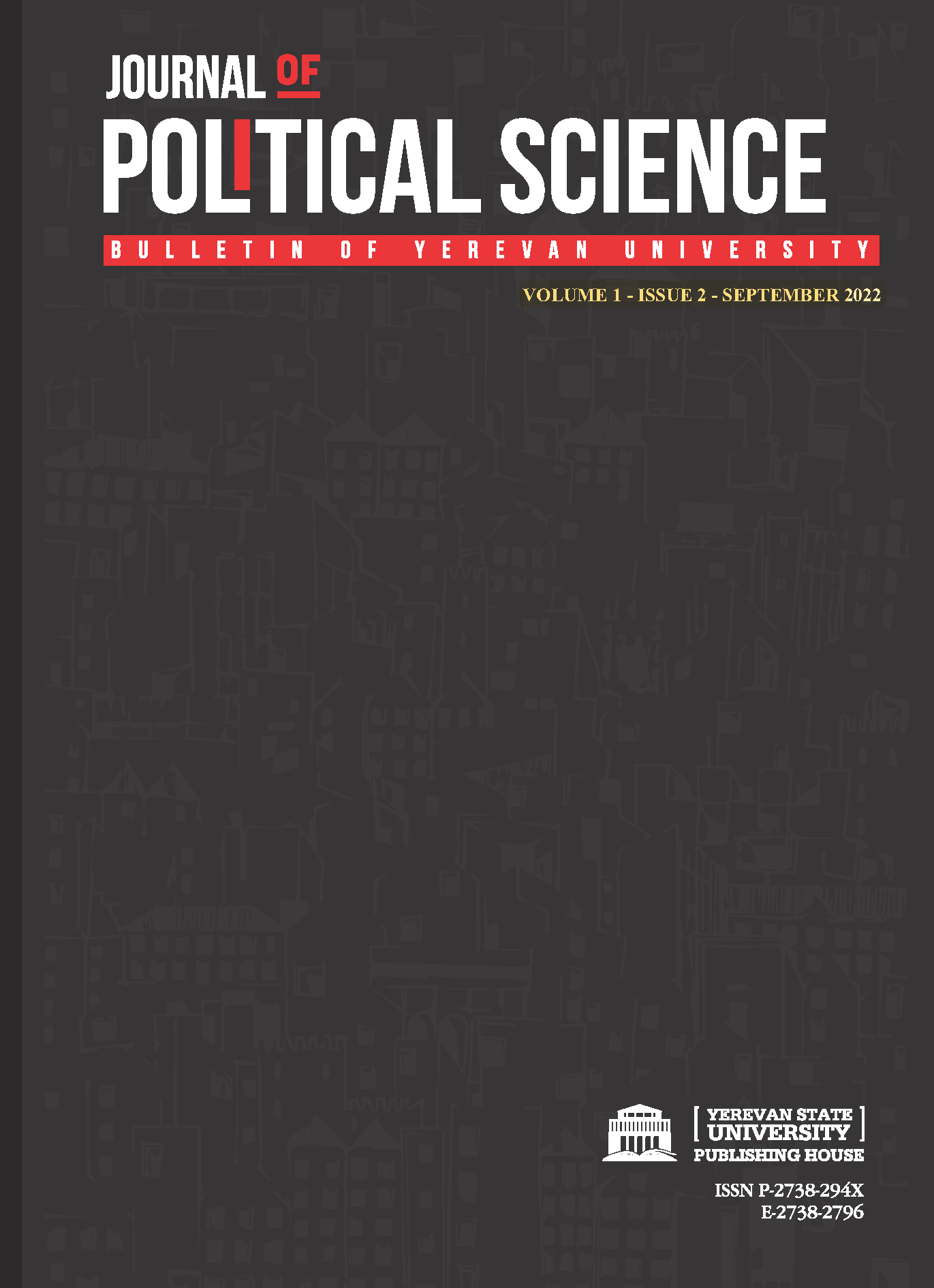Reflections on the Transformation of the World Order: Emerging Trends and Impending Perspectives
DOI:
https://doi.org/10.46991/JOPS/2022.1.2.092Keywords:
transformation, world order, hegemony, decline, financial landscape, China, the USA, Bretton-Wood institutions, US dollar, militaryAbstract
The article analyzes the latest trends of the started process of transformation of world order, trying to explain it by various concepts, bringing forward by researchers and scientists, substantiating for many decades the urgent need for the existence of a dominant state - a hegemon which plays a role of a stabilizer of the international relations. The article focuses on the concept of hegemonic stability, arguing that existence of hegemon especially in the political and economic system is a necessary condition for maintaining global peace and stability.
Special attention is paid to the conditions that contribute to the decline of hegemony. Drawing parallels between today's realities and the concepts, highlighted by Charles Kindleberger, Robert Gilpin, Immanuel Wallerstein and other researchers, the article proves that even based on the concepts of the mentioned researchers who for many years justified the “stabilizing role” of the US hegemony, after the global fanatical crisis of 2008 a new phase of development is becoming more and more noticeable. Referring to the point of view of I. Wallerstein, the article concludes that even maintaining dominance to a certain extent in a number of areas, such as military, political, the unipolar world order has already gone down in history.
References
Daye, Chu. 2019. “Russia and India can challenge SWIFT hegemony.” Global Times, October 22. Accessed July 26, 2022. https://www.globaltimes.cn/content/1168382.shtml.
Eichengreen, Barry, and Masahiro Kawai, еd. 2015. Renminbi Internationalization. Achievements, Perspectives and Challanges. Tokyo, Washington, D.C.: Asian Development Bank Institution, Brookings Institution.
Eurostat. 2022. “Share of European Union EU27 in world trade.” Accessed July 27, 2022. https://ec.europa.eu/eurostat/databrowser/view/EXT_LT_INTROEU27_2020__custom_3009927/settings_1/table?lang=en.
Gilpin, Robert. 1981. War and Change in World Politics. Cambridge: Cambridge University Press.
Gilpin, Robert. 2001. Global Political Economy, Understanding the International Economic Order. New Jersey: Princeton University Press.
Hanemann, Thilo, Daniel H. Rosen, Mark Witzke, Steve Bennion, and Emma Smith. 2021. Two-Way Street: 2021 Update US-China Investment Trends. The US-China Investment Project Report, New York: Rhodium Group, National Committee on US-China Relations.
Hopkins, Terence K., and Immanuel Wallerstein. 1982. World-Systems Analysis: Theory and Methodology. Beverly Hills, California: Sage Publications.
International Monetary Fund. 2021. “Special drawing rights (SDR).” Accessed July 27, 2022. https://www.imf.org/en/About/Factsheets/Sheets/2016/08/01/14/51/Special-Drawing-Right-SDR.
International Monetary Fund. 2022. “International financial statistics. Currency composition of official foreign exchange reserves (COFER).” Accessed July 27, 2022. https://data.imf.org/regular.aspx?key=41175.
Kindleberger, Charles. 1973. The World in Depression, 1929-39. Berkley: University of California Press.
Krasner, Stephen D. 1976. “State Power and the Structure of International Trade.” World Politics 28 (3): 317-347. https://doi.org/10.2307/2009974
Kwon, Roy. 2011. “Hegemonies in the World-System: An Empirical Assessment of Hegemonic Sequences from the 16th to 20th Century.” Sociological Perspectives 54 (4): 593-617. https://doi.org/10.1525/sop.2011.54.4.593.
McNally, Christopher A. 2022. “Saudi Arabia’s Oil Exports and the Yuan.”Accessed July 26, 2022. https://www.chinausfocus.com/finance-economy/saudi-arabias-oil-exports-and-the-yuan.
Mishra, Rahul. 2016. “Asian Infrastructure Investment Bank: An Assessment.” India Quarterly 72 (2): 163-176. https://doi.org/10.1177/0974928416643582.
United Nations Conference on Trade and Development. 2022. “World Investment Report 2022, FDI flows, by region and economy, 2016-2021.” New York: UNCTD. Accessed July 27, 2022. https://unctad.org/system/files/official-document/wir2022_en.pdf.
Wallerstein, Immanuel. 1980. The Modern World-System II: Mercantilism and the Consolidation of the European World-Economy, 1600-1750. New York: New York Academy Press.
Winecoff, William K. 2020. ““The persistent myth of lost hegemony,” revisited: structural power as a complex network phenomenon.” European Journal of International Relations 26 (1): 209-252. https://doi.org/10.1177/1354066120952876.
World Bank data. 2022. “GDP annual growth.” Accessed July 27, 2022. https://databank.worldbank.org/indicator/NY.GDP.MKTP.KD.ZG/1ff4a498/Popular-Indicators#.
World Bank data. 2022. “Nominal Gross Domestics Product (GDP) data.” Accessed July 27, 2022. https://data.worldbank.org/indicator/NY.GDP.MKTP.CD?end=2020&locations=US-CN-JP&start=1960&view=chart.
World Bank. 2022. “World Bank Group Finances. Top 8 countries voting power.” Accessed July 27, 2022. https://finances.worldbank.org/Shareholder-Equity/Top-8-countries-voting-power/udm3-vzz9.
World’s Top Exports. 2022. “Crude oil export by countries.” Accessed July 27, 2022. https://www.worldstopexports.com/worlds-top-oil-exports-country/.
World’s Top Exports. 2022. “Crude oil import by countries.” Accessed July 27, 2022. https://www.worldstopexports.com/crude-oil-imports-by-country/.
Downloads
Published
How to Cite
Issue
Section
License
Copyright (c) 2022 Karine Khojayan

This work is licensed under a Creative Commons Attribution-NonCommercial 4.0 International License.







